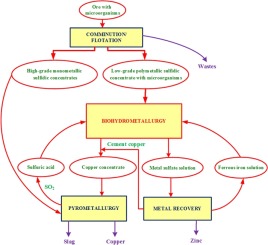Journal of Environmental Management ( IF 8.0 ) Pub Date : 2018-08-13 , DOI: 10.1016/j.jenvman.2018.08.045 Natalya V. Fomchenko , Maxim I. Muravyov

|
Polymetallic concentrates obtained during ore beneficiation pose a significant problem for the mining and metallurgy industry due to an increase in load on subsequent comminution steps and a high loss of metals in slag during smelting. Storage of such slag can lead to pollution of groundwater due to weathering. Biohydrometallurgy is an option for the processing of sulfidic raw materials that has a low impact on the environment. Processing of sulfidic concentrates of copper-zinc ore via bioleaching techniques was studied in this paper. Three mixed microbial cultures of acidophilic microorganisms were enriched from industrial mining sites: two autotrophic mesophilic cultures containing Acidithiobacillus ferroxidans and Leptospirillum spp. (grown at 30 and 35 °C), and a mixotrophic moderate thermophilic culture containing Sulfobacillus thermotolerans, Leptospirillum ferriphilum, as well as the archaea Ferroplasma acidiphilum and Acidiplasma spp. (grown at 40 °C). The autotrophic microbial culture growing at 30 °C was used to generate an iron-containing biosolution for ferric leaching of a copper-zinc concentrate. Zinc and iron extracted into solution faster than copper during high-temperature (80 °C) ferric leaching of the concentrate due to galvanic interactions between minerals, redox conditions of the medium, and differences between mineral oxidation mechanisms. Weight loss of the leach residue was 34.0%, with relative copper content increased by 1.0%, zinc content decreased by 6.18%, and iron content decreased by 15.1%. Biooxidation of ferrous iron in the pregnant leach solution by three microbial cultures was also studied. The most effective culture was moderate thermophilic. The results of studies on the bioregeneration of leaching solutions are relevant to the development of a two-step biohydrometallurgical technology for processing of copper-zinc concentrate with a closed cycle of technological flows. The ferrous iron biooxidation rate by the moderate thermophilic culture reached 20 g L−1 day−1. The leach residue obtained can be considered a high-grade copper concentrate able to be processed via smelting. This bioleaching process would make it possible to reduce pollution of groundwater by some toxic metals stored in slags. An environmentally friendly technology flow sheet for copper-zinc sulfidic ore processing using two-step bioleaching treatment was proposed.
中文翻译:

铜锌精矿加工的两步生物湿法冶金技术,以减少对环境的负面影响为契机
在选矿过程中获得的多金属精矿对采矿和冶金行业来说是一个重大问题,因为后续粉碎步骤的负荷增加,并且冶炼过程中炉渣中的金属大量流失。这种矿渣的储存会由于风化而导致地下水污染。生物湿法冶金是处理对环境影响较小的硫化原料的一种选择。本文研究了通过生物浸出技术处理铜锌矿石硫化精矿的方法。从工业采矿场中富集了三种嗜酸微生物的混合微生物培养物:两种自养嗜中性培养物,其中含有铁氧化酸硫杆菌和钩端螺旋体spp。(在30和35℃下生长),和含有混合营养中等嗜热培养物硫化杆菌thermotolerans,钩端螺嗜铁钩端螺旋菌,以及古细菌铁原体acidiphilum和Acidiplasmaspp。(在40°C下生长)。在30°C下生长的自养微生物培养物用于产生含铁生物溶液,用于铁浸出铜锌精矿。由于矿物质之间的电流相互作用,介质的氧化还原条件以及矿物质氧化机制之间的差异,在高温(80°C)的铁精矿浸出过程中,锌和铁的萃取速度要比铜快。浸出残渣的失重为34.0%,相对铜含量增加了1.0%,锌含量减少了6.18%,铁含量减少了15.1%。还研究了三种微生物培养液对孕浸出溶液中亚铁的生物氧化作用。最有效的培养是中等嗜热性。浸出液生物再生的研究结果与开发具有封闭工艺流程的铜锌精矿两步生物湿法冶金技术的发展有关。通过适度的嗜热培养,亚铁的生物氧化速率达到20 g L-1天-1。可以将获得的浸出残渣视为可以通过冶炼加工的高级铜精矿。这种生物浸出过程将有可能减少矿渣中储存的某些有毒金属对地下水的污染。提出了一种采用两步生物浸出工艺处理铜锌硫化矿石的环保工艺流程。











































 京公网安备 11010802027423号
京公网安备 11010802027423号